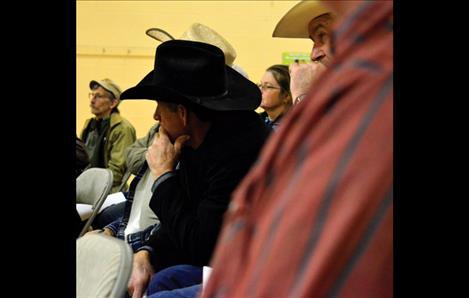Water fees explained during meeting
Hey savvy news reader! Thanks for choosing local.
You are now reading
1 of 3 free articles.
ST. IGNATIUS – Many feared that the cost of using irrigation water would go up by $7.50 per acre last summer.
Stanley Speak, the northwest regional director for the Bureau of Indian Affairs, announced by phone at the Flathead Indian Irrigation Project’s semi-annual water users meeting on Tuesday that the increase will not happen in 2016 — although an increase is scheduled for 2017.
“The rate of increase is not yet determined,” said Pete Plant, acting project manager for the FIIP. He added that more information about the 2017 increase will be available in April 2016. He said the $7.50 figure is only a proposal at this time.
During the meeting, Plant updated the public on issues pertaining to the FIIP budget, project repairs and predictions for next year. He said the approved budget income for 2015 was $3,345,986 with a slightly higher income after BIA funds were included at $3,409,615.
Plant explained exactly where the money was used. He said 65.8 percent of the budget went towards employee costs at $2,200,000. Vehicle operations took 9.4 percent of the budget at $314,000. Pumping costs took another 9.4 percent at $317,500. Material supplies were at 7.4 percent for $246,586. Administrative expenses were at 2.3 percent for $79,113. Other costs including travel were set at 8 percent for $40,128.
He said about $500,000 was left in the budget in November, which was used to pay end-of-the-year costs including utilities and project materials. Anything left is put into emergency reserves.
Next year’s budget looks identical to the 2015 budget, he said. Although, changes will be made to increase the percentage of the funding going towards employees.
“We are hiring more ditch riders,” he said explaining that two lead riders will be added along with six regular ditch riders for a total of 43 employees. Plant said employee costs will be paid for from lower fuel costs and additional budget arrangements. The ditch riders deliver the water when farmers and ranchers put in an order. They also help with seasonal maintenance.
Over the past year, Plant said maintenance progressed as usual on the 1,300 miles of canals and lateral systems with 10,000 minor structures for water diversion.
“It was a typical year,” he said, adding that the aging infrastructure is more than 100 years old so it often needs to be repaired.
The biggest problem this year happened near the end of the summer in Pablo below Post Creek, and it had the potential to shut off water flow even sooner than the dry conditions necessitated.
“There was seepage coming out from the canal bank at a good flow rate,” he said of the Pablo location. “It was caught and repaired. If that hadn’t been caught it had the potential to blow out and end water movement to the north end of the valley and damage Post Creek.”
Plant doesn’t usually start making predictions about next year’s water reserves until he gets a look at the snowpack in March and April, but he started looking into what other climate resources are predicting to get a jump start on planning after last year’s dry conditions.
“It looks like we are going to have above average temperatures and below average precipitation, again,” he said explaining that it could be another hot and dry summer. He plans to start storing water as soon as runoff from the melting snowpack starts coming down from the mountains next year.

















